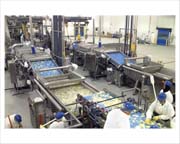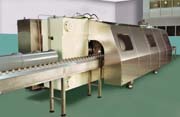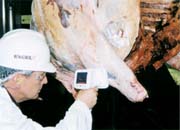Semper Vigilante

While ground beef and ready-to-eat meats are top-of-mind categories when it comes to food-safety concerns, 2003 offered a chilling reminder of the pervasiveness of the danger. The dubious distinction of America's worst incident of food borne illness involved the humble green onion.
More than 600 confirmed cases, including three deaths, were tied to November's outbreak of Hepatitis A infections of patrons at a Chi-Chi's restaurant in western Pennsylvania. The case dramatizes two important points in the effort to deliver safe food to American tables: produce as well as meats, beverages and other foods is just as vulnerable to contamination, and bacteria aren't the only danger. Viruses such as Hepatitis A, mycotoxins from fungi, even yeast and mold can be lethal to consumers. Effective food safety practices must be cognizant of the range of contaminants that compromise product safety.
Though the green onions came from Mexico, the fragmented nature of all farm-level operations creates a challenge for processors, the next link in the food chain, points out John Hedges, vice president with Sun Belle Inc., a Melrose Park, Ill., importer and distributor of greenhouse fruits and vegetables. "The Hepatitis A infections are a big wake-up call," says Hedges.
According to a report by the Center for Science in the Public Interest, there were 3,981 U.S. illnesses caused by contaminated produce in 2000. The same year, a combined 4,025 individuals became ill from contaminated beef, poultry, seafood and eggs. Observers disagree what proportion of illnesses are attributable to farm practices compared to infected workers and poor sanitation in food preparation and processing, but the study dramatizes the need for safeguards in all types of food processing.

Similar recommendations for produce processors are incorporated in the drain management component of Ecolab's EcoShield program, according to microbiologist John Hilgren. "Listeria does well in the cool and wet environment of a fresh-cut vegetable plant," he points out. "Non-food contact surfaces are equally important to the contact surfaces, and drains are important harborage sites. That's why we advise clients not to employ high-pressure spraying during production to prevent aerosoling of microbes in drains."
Continuous or intermittent spritzing of conveyor belts with an antimicrobial solution is another best practice advocated by Ecolab in fruit & vegetable processing. The same strategy is in place at Beef Processors Inc. (BPI), a supplier of 95 percent lean ground beef to makers of hamburger patties. Belts coated or impregnated with antimicrobial treatments such as AgION silver ion is another safety tactic.

Technology's mixed bag
Irradiation is being used to kill insects on imported produce and as a safety measure for spices, and processors of fruits and vegetables are evaluating the technology for an expanded role. "There's at least more interest in it," reports Hilgren, though the economics of application to low-margin products are uncertain.Irradiation is an effective safety measure for meat, but the outlook for widespread application is beginning to dim. "For beef, it's never going to happen," believes Emmpak's Rourke, "and for precooked meats, it's illegal." He is more upbeat about high pressure processing (HPP), a niche application that could benefit from the entry of new suppliers.
The latest is NC Hyperbaric, a Burgos, Spain, division of a company that makes milling machines. Since its first deployment two years ago, Hyperbaric has put 50 commercial units into operation in Italy, Portugal and Spain, according to Carole Tonello, a food technologist with the firm. HPP units from Flow International's Avure Technologies feature a vertical design; Hyperbaric uses a horizontal alignment to speed the loading and unloading process. It takes less than a minute to fill the chamber with water before each batch, and high-pressure valves empty it in seconds, Tonello says.
Hyperbaric's system will process 1,800 lbs. of product an hour, the same as Avure's, according to Rourke, and Avure has reduced equipment prices in an effort to expand the HPP market. Avure's parent has indicated it is reevaluating its focus on HPP in food and beverage. "At this point, there are no commitments," says Avure's Pat Adams. "Candidly, we'd like to keep the business. We're not going away."
An innovative safety practice that recently made its commercial debut is activated lactoferrin, a wash-cabinet treatment for beef carcasses ("Medical microbiology for pathogen prevention," Food Engineering, September 2003). Rather than kill microbes, charged molecules of lactoferrin attach themselves to pathogens on the meat and are then rinsed off, preventing microbial colonization. The system was developed by aLF Ventures and has been used commercially since October 27 at National Beef Packing Co. plants in Liberal and Dodge City, Kan. It is the latest addition to a food safety strategy that includes testing, tracking and multiple interventions.
"We had a few problems learning about the static electricity that charges the system, and we're still dialing the system in, but it's running all the time," reports Terry Wilkerson, National's executive vice president of operations. "It's performing as advertised and meeting line speeds." The application cabinet follows a thermal pasteurization step and precedes a final carcass rinse.
Fecal contamination is endemic in beef slaughter operations. Cleaning the livestock before they enter the processing area is a logical strategy. One of the most ambitious technologies attempted to accomplish that was at Future Beef Operations, Food Engineering's 2002 Plant of the Year ("Revolutionary from inception to ingestion," June 2002). Hair, mud and waste were removed before the butchering process began, minimizing the danger of cross contamination when subcutaneous incisions are made.
Dehairing requires a separate water treatment system and large amounts of water, points out Matt Osborn, senior food scientist with Cargill Inc.'s Excel beef operations in Wichita, Kan. In mid-2002, Excel began development of its own hide washing system that "may make dehairing obsolete," Osborn predicts.
Resembling a car wash for cattle, the system relies on a caustic solution delivered under high pressure to raise the pH of the hair and epidermis of the animal, effectively neutralizing any E. coli and Salmonella present. The carcass then undergoes a chlorine rinse. Before it reaches the butcher, the hide is vacuumed and squeegeed to remove any loose hair and oil that may be harboring bacteria.
"A lot of people have tried to attack the problem of contamination on hides, but nobody had attempted a full-court press like this before," Osborn says. "To make it work, we use a lot of oscillation and mechanical action, and we developed a water re-use that helps buffer the waste in our lagoons."
The first system was installed last spring in Excel's Schuyler, Neb., plant. An analysis by USDA's Agricultural Research Service in Clay Center, Neb., concluded E. coli is present on almost all hides entering beef slaughterhouses. With the washing system, the frequency is slashed to 30 percent.
"We've seen a 90 percent to 99.9 percent reduction in bacteria loads," Osborn reports. "If our animals come in extremely dirty, we can get up to a 4 Log (99.99 percent) reduction. Four facilities now have the system, with two more slated.
Cargill plans to license the system to other slaughter operations, according to Mark Klein, public affairs director. "Making the technology available to the industry is the right thing to do," he says. "Raising the safety bar for the industry as a whole ultimately benefits us, as well."

Turn on the light
Excel's Schuyler plant also served as the beta site for VerifEYE, a microbial detection system developed by USDA and Iowa State University and commercialized by eMerge Interactive Inc. ("Putting contaminants in a new light," Food Engineering, July/August 2002). Bacteria in the intestines of cattle can contaminate the carcass during evisceration. VerifEYE measures radiated light from organic matter on the carcass surface to flag problem areas.Fluorescent light of a specific wavelength is the key to the detection system. The light signal must be filtered and amplified, much as the light produced by adenosinetriphosphate (ATP) is amplified in a luminometer to generate a quick measure of the general cleanliness of food-contact surfaces. ATP tests have been used for 20 years in segments of the food industry, and their use is spreading. Results from ATP swab tests are available in minutes and provide a useful gauge to the relative number of living cells on a surface because of the correlation between light production and ATP concentration. Ecolab's Hilgren views ATP assays as a good preliminary validation of sanitation processes but cautions that they should be used in conjunction with other tests.
Spectroscopy also serves peanut processors in mycotoxin screening. The aflatoxin B1 strain can be lethal in concentrations as low as one part per billion, according to mycologist Thomas J. Volk of the University of Wisconsin-LaCrosse. Aflatoxin glows under ultraviolet light, which has prompted peanut butter makers to install UV systems to detect and reject contaminated peanuts prior to processing. ELISA kits and other resting technology also can detect the toxin, but the immediacy of fluorescent screening makes it a valuable food safety tool.
Rapid testing is an area where technology lags processors' needs, safety experts agree. "Tests are faster than they used to be but not fast enough yet," says Ecolab's Hilgren. "Microbiological techniques take days to get a positive result," and that limits their utility with perishable products.
BPI has instituted a test-and-hold policy for its frozen ground beef. Emmpak has upped the ante by applying test-and-hold to fresh beef. Working with Silliker Labs, Emmpak samples finished product every 15 minutes and relies on an E. coli 0157:H7 test that requires an eight-hour incubation. An 18-hour hold is placed on all products. "Nothing leaves until we get those results, and that was hard," notes Rourke. If a sample comes back positive, all product produced an hour before and after that lot is rejected.
A less dramatic safety practice that processors are employing is a lubrication audit. Shell Cassida pioneered the concept overseas several years ago and began conducting North American reviews last year, according to Debbie Hodson, industrial sector marketing manager. Although 21 CFR Part 178.3570 of the food code sets zero tolerance for incidental contact of non-food grade lubricants (and 25 ppm for food-grade lubes), an independent study in 2001 concluded only two out of five food and beverage facilities are using any food-grade lubricants. "That's a huge opportunity for Shell but also scary from a food safety perspective," says Hodson.
Anderol Specialty Lubricants has rolled out a similar audit program, offering to evaluate hydraulic systems, mechanical lubrication points, storage practices and the integrity of seals and pipe joints throughout a plant. Sophisticated lab tests of finished goods helped pinpoint what became of large quantities of one client's oil, says Anderol's Garrett Grega. "Our laboratory numbers confirmed that most of it ended up in the product."

Sealed-for-life bearings offer relief from oil-contamination worries, and more processors are specifying that feature in equipment orders. Stainless steel construction is a must for most processing equipment, and designs that aid cleaning and eliminate liquid collection points are demanded by the most scrupulous manufacturers. The same standards are beginning to be applied to packaging equipment. Multivac Inc. recently received ANSI/NSF/3-A certification for the sanitary design of its R530 rollstock vacuum packaging machine. Redesign of other models is underway, according to Bob Koch, sales director of the Kansas City firm.
"These sanitary design standards are the highest in the world," says Koch. "If there wasn't a need, we wouldn't do it because it costs money, and we have to pass those costs on."
Controls are housed in a NEMA 4X panel, a concession to the washdown environment. Besides facilitating hygienic procedures, watertight panels will save countless hours of cleaning and sanitizing compared to conventional packaging units. Because of the sensitivity of exposed controls, it takes eight hours to clean a candy-wrapping machine manually, says Guy DeVincentis, a food-plant sanitation expert with Aramark. To speed the process, he is equipping crews with machines from Cold Jet that spray dry ice pellets at 1,700 psi. "You're freezing residue on the surfaces and shocking the dirt off," DeVincentis says. "It's terrific for cleaning candy wrapper machines."
His crews use dry ice only in the packaging area. For the rest of the plant, he advocates foamers that can shoot chlorinated caustics up to 60 ft. to clean and sanitize hard-to-reach areas of the plant. Though used extensively in USDA facilities, foamers represent a food-safety upgrade in snack foods and other processing venues, DeVincentis says.
One Aramark client who can attest to the efficacy of foamers is Zapp's Potato Chip Co. in Gramercy, La. Two years ago, the firm acquired the Dirty Potato Chips brand, expanding distribution to California and the Northeast and putting sanitation procedures in a bind. The last production shift also handled clean up, and expanding production meant less time to accomplish it. "We had been using soap and water, and we just weren't doing a good job removing grease from fryer hoods and building surfaces," recalls Mike Druin, director of operations. "Outsourcing the work has made a marked difference. Everything's brighter, and my local health people like it, too."
With attention to food safety ratcheting up, outsourcing a critical practice makes sense if it improves the integrity of the finished goods. Whether it's equipment design, testing procedures or processing interventions, food manufacturers are tapping a wealth of resources to improve food safety practices.
For more information:
David R. Hall, aLF Ventures,
801-961-1035,
drhall@activinlf.com
Garrett Grega, Anderol Specialty Lubricants, 973-887-7410, ext. 523,
ggrega@anderol.com
Guy DeVincentis, Aramark, 636-357-3844
Pat Adams, Avure Technologies,
253-813-2712,
padams@flowcorp.com
John Hilgren, Ecolab, 651-293-2233,
john.hilgren@ecolab.com
Bob Koch, Multivac, 816-891-0555
Carole Tonello, NC Hyperbaric, 011-34 947 298 244,
c.tonello@correa.es
Debbie Hodson, Shell Cassida, 713-546-3759
Looking for a reprint of this article?
From high-res PDFs to custom plaques, order your copy today!




